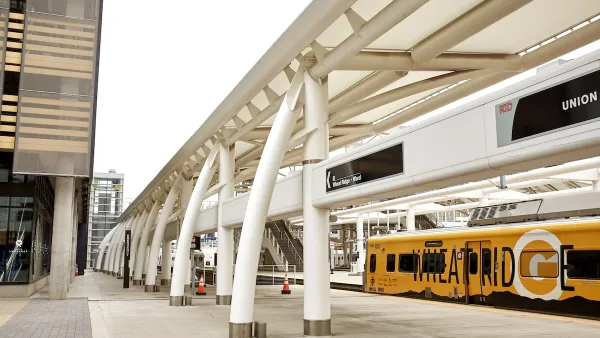The sight of trains passing by luxury condos might be foreign to some cities, but not Denver. The risk posed by crude oil shipments passing on those rails, however, is too much for some residents to accept without a plan.
Jon Murray reports on a growing concern in the Denver area about freight trains carrying crude oil shipments through urban neighborhoods of all kinds—"old and new, upscale and hardscrabble."
Some residents have made appeals, "met with mixed success," for increased emergency plans. "The issue prompted a rare budget amendment dispute in early November between Mayor Michael Hancock and a majority of the City Council, led by at-large member Debbie Ortega," according to Murray. "Hancock rejected their amendment to fund a $250,000 outside safety study. Instead, he ordered up a working group, led by Fire Chief Eric Tade, that by July 1 will examine what more the city might do to reduce risks."
There is a little of a "who was here first" dilemma at play in the controversy. The rail lines and train yards predate a lot of the neighborhoods and developments in the Central Platte Valley, but increasing crude shipments have raised the stakes of putting those transportation routes in such close proximity to residential neighborhoods. Murray explains the crude oil shipments through the city as part of a broader trend: "Nationally, crude oil volume on the rails has skyrocketed from just shy of 10,000 tank cars in 2008 to about 500,000 last year, The Associated Press recently reported."
FULL STORY: Oil trains raise alarm for Denver residents in growing neighborhoods

Planetizen Federal Action Tracker
A weekly monitor of how Trump’s orders and actions are impacting planners and planning in America.

Restaurant Patios Were a Pandemic Win — Why Were They so Hard to Keep?
Social distancing requirements and changes in travel patterns prompted cities to pilot new uses for street and sidewalk space. Then it got complicated.

Map: Where Senate Republicans Want to Sell Your Public Lands
For public land advocates, the Senate Republicans’ proposal to sell millions of acres of public land in the West is “the biggest fight of their careers.”

Maui's Vacation Rental Debate Turns Ugly
Verbal attacks, misinformation campaigns and fistfights plague a high-stakes debate to convert thousands of vacation rentals into long-term housing.

San Francisco Suspends Traffic Calming Amidst Record Deaths
Citing “a challenging fiscal landscape,” the city will cease the program on the heels of 42 traffic deaths, including 24 pedestrians.

California Homeless Arrests, Citations Spike After Ruling
An investigation reveals that anti-homeless actions increased up to 500% after Grants Pass v. Johnson — even in cities claiming no policy change.
Urban Design for Planners 1: Software Tools
This six-course series explores essential urban design concepts using open source software and equips planners with the tools they need to participate fully in the urban design process.
Planning for Universal Design
Learn the tools for implementing Universal Design in planning regulations.
Heyer Gruel & Associates PA
JM Goldson LLC
Custer County Colorado
City of Camden Redevelopment Agency
City of Astoria
Transportation Research & Education Center (TREC) at Portland State University
Camden Redevelopment Agency
City of Claremont
Municipality of Princeton (NJ)





























